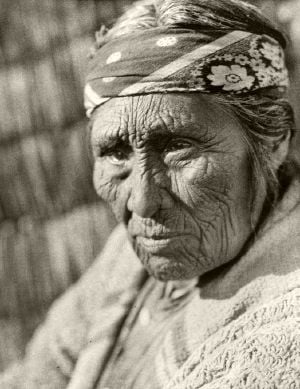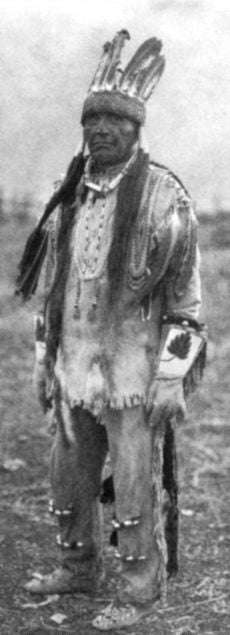Klamath

The Klamath are a Native American tribe of the Plateau culture area in Southern Oregon.
History
Pre-contact
Prior to the arrival of European explorers, the Klamath people lived in the area around the Upper Klamath Lake and the Klamath, Williamson, and Sprague rivers. They subsisted primarily on fish and gathered roots and seeds.
The Klamath were known to raid neighboring tribes (such as the Achomawi on the Pit River), and occasionally to take prisoners as slaves. They traded with the Chinookan people at The Dalles.
Contact
In 1826, Peter Skene Ogden, an explorer for the Hudson's Bay Company, first encountered the Klamath people, and he was trading with them by 1829.
Treaty with the United States
Treaty with the United States
The United States, the Klamaths, Modocs, and Yahooskin band of Snake tribes signed a treaty in 1864, establishing the Klamath Reservation, to the northeast of Upper Klamath Lake. The treaty had the tribes cede the land in the Klamath Basin, bounded on the north by the 44th parallel, to the United States. In return, the United States was to make a lump sum payment of $35,000, and annual payments totaling $80,000 over 15 years, as well as providing infrastructure and staff for the reservation. The treaty provided that, if the Indians drank or stored intoxicating liquor on the reservation, the payments could be withheld and that the United States could locate additional tribes on the reservation in the future. The tribes requested Lindsay Applegate as the agent to represent the United States to them. The Indian agent estimated the total population of the three tribes at about 2,000 when the treaty was signed.
Post-treaty history
Since termination of recognition of their tribal sovereignty in 1954 (with federal payments not disbursed until 1961), the Klamath and neighboring tribes have reorganized their government and revived tribal identity. The Klamath, along with the Modoc and Yahooskin, have formed the federally recognized Klamath Tribes confederation. Their tribal government is based in Chiloquin, Oregon.
Some Klamath live on the Quartz Valley Indian Community in Siskiyou County, California.
A fictionalized account of historical events surrounding the 1961 tribal termination can be found in the 2005 Rick Steber novel Buy the Chief a Cadillac,[1] winner of the 2005 Spur Award.
Culture
Language
The language of the Klamath tribe is a member of the Plateau Penutian family. Klamath was previously considered a language isolate.
The Klamath-Modoc (or Lutuamian) language has two dialects:
- Klamath
- Modoc
Both peoples called themselves maklaks, meaning people. When they wanted to distinguish between themselves, the Modoc were called Moatokni maklaks, from muat meaning "South." The Klamath people were called Eukshikni, meaning "lake people."
Classifications
The Klamath people are grouped with the Plateau Indians—the peoples who originally lived on the Columbia River Plateau. They were most closely linked with the Modoc people.
Klamath tribes
The Klamath Tribes, formerly the Klamath Indian Tribe of Oregon, are a federally recognized confederation of three Native American tribes who traditionally inhabited Southern Oregon and Northern California in the United States: the Klamath, Modoc, and Yahooskin. The tribal government is based in Chiloquin, Oregon.
After signing the 1864 treaty, members of the Klamath Tribes lived on the Klamath Reservation until the United States Congress terminated its recognition of tribal sovereignty in 1954. In 1986, federal recognition was restored, but some of the tribe's original land had been sold. A portion of that land is now part of the Klamath Basin National Wildlife Refuges Complex. A new reservation is in the planning stages.[2]
The Klamath Tribes have 3700 enrolled members (as of 2006)[citation needed], and are centered in Klamath County, Oregon. Some of the lands that the tribe liquidated when they lost federal recognition in 1954 were restored when recognition returned, so the tribal administration offers services throughout the county.
The Kla-Mo-Ya Casino was opened in Chiloquin, Oregon in 1997 and now provides an income stream to the tribes to support their activities.
Klamath Indian Reservation
The present day Klamath Indian Reservation consists of twelve small non-contiguous parcels of land in Klamath County.[citation needed] These fragments are generally located in and near the communities of Chiloquin and Klamath Falls. Their total land area is 1.248 km² (308.43 acres). As is the case with many Native American tribes[citation needed], few of the Klamath tribal members actually live on reservation land; the 2000 census reported only nine persons residing on its territory, five of whom were white people.[3]
Water rights dispute
In 2001, an ongoing water rights dispute between the Klamath Tribes and Klamath Basin farmers and fishermen along the Klamath River became national news. As of 2006, the water rights issue is still controversial.
Footnotes
- ↑ Steber, R; Buy the Chief a Cadillac; Carroll & Graf Publishers, New York, 2006
- ↑ Indian Tribes in Oregon from the Oregon Blue Book website
- ↑ Klamath Reservation, Oregon. United States Census Bureau. Retrieved 2006-11-29.
ReferencesISBN links support NWE through referral fees
- Hale, Horation. 1892. "The Klamath Nation: the country and the people." Science, Vol. 19, No. 465.
- Hodge, Frederick Webb. 1907. Handbook of American Indians north of Mexico. Washington: Government Printing Office.
- Mithun, Marianne. 1999. The languages of Native North America. Cambridge: Cambridge University Press. ISBN 0-521-23228-7 (hbk); ISBN 0-521-29875-X.
- Sides, Hampton. 2006. Blood and Thunder. Doubleday. ISBN 0-385-50777-1.
- Waldman, Carl. 1999. Encyclopedia of Native American Tribes. New York: Checkmark. ISBN 0-8160-3964-X
- 1865. Annual report of the Commissioner of Indian Affairs to the Secretary of the Interior for the year 1865: Reports of Agents in Oregon Washington: United States Office of Indian Affairs.
External links
- Guide to the Klamath Tribal Council papers (1933-1958) at the University of Oregon
- Klamath Reservation General Council
- Klamath Tribes
- Southern Oregon Digital Archives
Credits
New World Encyclopedia writers and editors rewrote and completed the Wikipedia article in accordance with New World Encyclopedia standards. This article abides by terms of the Creative Commons CC-by-sa 3.0 License (CC-by-sa), which may be used and disseminated with proper attribution. Credit is due under the terms of this license that can reference both the New World Encyclopedia contributors and the selfless volunteer contributors of the Wikimedia Foundation. To cite this article click here for a list of acceptable citing formats.The history of earlier contributions by wikipedians is accessible to researchers here:
The history of this article since it was imported to New World Encyclopedia:
Note: Some restrictions may apply to use of individual images which are separately licensed.
